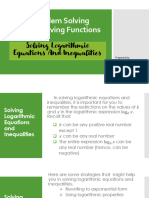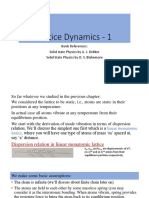Notes+Key+Topic+2.11+Logarithmic+Functions
Uploaded by
Ciel PhantomhiveNotes+Key+Topic+2.11+Logarithmic+Functions
Uploaded by
Ciel PhantomhiveNotes: (Topic 2.
11) Logarithmic Functions Solutions
Because logarithmic functions and exponential functions are inverse functions, the characteristics of their graphs will have
inverse relationships.
Key Characteristics of Logarithmic Functions
A logarithmic function has the general form
Domain: ( 0, ¥ )
𝑓(𝑥) = 𝑎 log𝑏 𝑥 , 𝑏>0
where 𝑎 and 𝑏 are constants with 𝑎 ≠ 0 and 𝑏 ≠ 1.
Range: ( -¥, ¥)
Logarithmic Functions Logarithmic Functions
𝑎 > 0 and 𝑏 > 1 𝑎 < 0 and 𝑏 > 1
Increasing vs. Decreasing Concave Up vs. Concave Down
Logarithmic functions are always increasing or Logarithmic functions are always concave up or always
always decreasing! They will never switch from one concave down! They will never switch concavity, so they
to the other, so they have no relative (local) extrema have no points of inflection.
(unless on a closed interval).
End Behavior End Behavior Limit Statements
For logarithmic functions in general form, as the input
values (𝑥) increase without bound, the output values lim 𝑎 log & 𝑥 = ±∞ and lim 𝑎 log & 𝑥 = ±∞
#→%! #→"'
(𝑦) will increase/decrease without bound.
Since logarithmic functions have a restricted domain,
they are vertically asymptotic to 𝑥 = 0. As a result,
the left end behavior will occur as 𝑥 → 0" .
Example 1: Write limit statements for the end behavior of the following logarithmic functions.
a) b) c) g ( x ) = 2log3 x
𝑎 > 0 and 𝑏 > 1
𝐆𝐫𝐚𝐩𝐡 𝐨𝐟 𝒇(𝒙) 𝐆𝐫𝐚𝐩𝐡 𝐨𝐟 𝒉(𝒙)
Left: lim+ f ( x ) = −∞ Left: lim! ℎ(𝑥) = ∞ Left: lim! 𝑔(𝑥) = −∞
x ®0 #→% #→%
Right: lim 𝑓(𝑥) = ∞ Right: lim 𝑓(𝑥) = −∞ Right: lim 𝑓(𝑥) = ∞
#→' #→' #→'
Notes: Logarithmic Functions Topic 2.11 Created by Bryan Passwater
Solutions by Ted Gott tedg20776@gmail.com
Example 2: For each of the following, determine if the logarithmic function is increasing/decreasing and concave
up/down.
a) b) c) h ( x ) = -4log6 x
𝑎 < 0 and 𝑏 > 1
Concave Up or Concave Down Concave Up or Concave Down Concave Up or Concave Down
Increasing or Decreasing Increasing or Decreasing Increasing or Decreasing
Example 3: Selected values of the several logarithmic functions are shown in the tables below. For each table, find
the value of the constant 𝑘.
𝑥 𝑓(𝑥) 𝑥 𝑔(𝑥) 𝑥 ℎ(𝑥) 𝑥 𝑙(𝑥)
1 1 𝑘 0 4 10 𝑒 !" 7
2 2 6 5 5 0 𝑒 14
𝑘 3 18 10 7 −10 𝑘 21
8 4 54 15 𝑘 −20 𝑒# 28
16 5 162 20 19 −30 𝑒 $% 35
𝑥 values are powers of 2 𝑥 values are powers of 3 𝑥 − 3 are powers of 2 The exponents form a linear
1 = 2% 2 = 2) doubled 4 − 3 = 1 = 2% pattern 𝑝 = −2 + 3𝑛
𝑘 = 2* = 4 6 = 3) ∙ 2 18 = 3* ∙ 2 5 − 3 = 2 = 2) for 𝑛 = 0,1,2,3,4.
𝑓(𝑥) = log * 𝑥 + 1 𝑘 = 3% ∙ 2 = 2 7 − 3 = 4 = 2* 𝑘 = 𝑒 (.*"+∙* ) = 𝑒 ,
𝑥 𝑘 − 3 = 8 = 2+ ⇒ 𝑘 = 11 7
𝑔(𝑥) = 5 log + Q R 𝑙(𝑥) = (5 + ln(𝑥))
2 19 − 3 = 16 = 2, 3
ℎ(𝑥) = −10(log * (𝑥 − 3) − 1)
Example 4: Find the domain and range of the following logarithmic functions.
a) f ( x ) = 2log3 x b) g ( x ) = -5log 2 ( x - 3) c) h ( x ) = 8log ( 2 x + 3)
+
Domain: (0, ∞) Domain: (3, ∞) Domain: Q− * , ∞R
Range: (−∞, ∞) Range: (−∞, ∞) Range: (−∞, ∞)
Notes: Logarithmic Functions Topic 2.11 Created by Bryan Passwater
Solutions by Ted Gott tedg20776@gmail.com
You might also like
- Holt McDougal Florida Larson Algebra 1 PDF92% (13)Holt McDougal Florida Larson Algebra 1 PDF431 pages
- Exponential and Logarithmic Functions and Properties of Logarithms (13.1-13.3) Class NotesNo ratings yetExponential and Logarithmic Functions and Properties of Logarithms (13.1-13.3) Class Notes15 pages
- Notes Topic 2.10 Key - Inverses of Exponential FunctionsNo ratings yetNotes Topic 2.10 Key - Inverses of Exponential Functions2 pages
- GEN-MATH-Q1-Mod8-Log-Fn-Graph-Word-ProblemsNo ratings yetGEN-MATH-Q1-Mod8-Log-Fn-Graph-Word-Problems16 pages
- Solving Logarithmic Equations and Inequalities Part 1100% (1)Solving Logarithmic Equations and Inequalities Part 19 pages
- Lecture Transcript 4 (Logarithmic Functions)No ratings yetLecture Transcript 4 (Logarithmic Functions)10 pages
- 2.10_Inverses_Exponential_Functions_Key_2No ratings yet2.10_Inverses_Exponential_Functions_Key_26 pages
- HPC 3.1 Notes-Evaluating Exp and Log Functions 7thNo ratings yetHPC 3.1 Notes-Evaluating Exp and Log Functions 7th4 pages
- 03 - HW Function Limits Problems - SupplNo ratings yet03 - HW Function Limits Problems - Suppl3 pages
- Week 6 Advance Differentiation Rules Exponential and Logarithmic FunctionsNo ratings yetWeek 6 Advance Differentiation Rules Exponential and Logarithmic Functions21 pages
- Lecture 29 Exponential Function - 446459516No ratings yetLecture 29 Exponential Function - 4464595166 pages
- SHS GENMATH AY 23-24 6 Exponential and Logarithmic FunctionsNo ratings yetSHS GENMATH AY 23-24 6 Exponential and Logarithmic Functions26 pages
- Q2 Week 2 Graphing Polynomial and Rational FunctionsNo ratings yetQ2 Week 2 Graphing Polynomial and Rational Functions26 pages
- Pure 1 Chapter 14 Exponentials and LogsNo ratings yetPure 1 Chapter 14 Exponentials and Logs21 pages
- 6clase Limites Trigonometricos y ExponencialesNo ratings yet6clase Limites Trigonometricos y Exponenciales10 pages
- Class02_Advanced_Functions_Handout_July_02-07No ratings yetClass02_Advanced_Functions_Handout_July_02-078 pages
- Review+A+Unit+2+Topics+2.3+2.10+-+2.11+MCQ+Exp+and+Log+Graph+PropertiesNo ratings yetReview+A+Unit+2+Topics+2.3+2.10+-+2.11+MCQ+Exp+and+Log+Graph+Properties9 pages
- Worksheet_A_Key_Topic_2.11_Logarithmic_Functions__1_.pdfNo ratings yetWorksheet_A_Key_Topic_2.11_Logarithmic_Functions__1_.pdf2 pages
- 2_Maths_Ultimate_Question_Bank_20315004350wtverjNo ratings yet2_Maths_Ultimate_Question_Bank_20315004350wtverj305 pages
- Kinematical Compatibility Problems in Yield-Line Theory1967No ratings yetKinematical Compatibility Problems in Yield-Line Theory196712 pages
- Gradient Descent Intuition: Back To Week 1 LessonsNo ratings yetGradient Descent Intuition: Back To Week 1 Lessons3 pages
- MITx - 18.03Fx - DIFFERENTIAL EQUATIONS - FOURIER SERIES AND PARTIAL DIFFERENTIAL EQUATIONSNo ratings yetMITx - 18.03Fx - DIFFERENTIAL EQUATIONS - FOURIER SERIES AND PARTIAL DIFFERENTIAL EQUATIONS5 pages
- MA1200 Chapter 1 Coordinate Geometry - Solutions PDFNo ratings yetMA1200 Chapter 1 Coordinate Geometry - Solutions PDF6 pages
- Lattice Dynamics - 1: Book References: Solid State Physics by A. J. Dekker Solid State Physics by D. S. BlakemoreNo ratings yetLattice Dynamics - 1: Book References: Solid State Physics by A. J. Dekker Solid State Physics by D. S. Blakemore12 pages
- 1 995 Mathematics Olympiad Lecture Notes - Review of Logarithms - Greg Gamble - Logs100% (1)1 995 Mathematics Olympiad Lecture Notes - Review of Logarithms - Greg Gamble - Logs5 pages
- Calculus I Exercise 4.7.67 Fall 2017 SolutionNo ratings yetCalculus I Exercise 4.7.67 Fall 2017 Solution3 pages
- Concept of Local Maximum and Local Minimum Local Maximum: 1. First Derivative Test: IfNo ratings yetConcept of Local Maximum and Local Minimum Local Maximum: 1. First Derivative Test: If5 pages

























































































